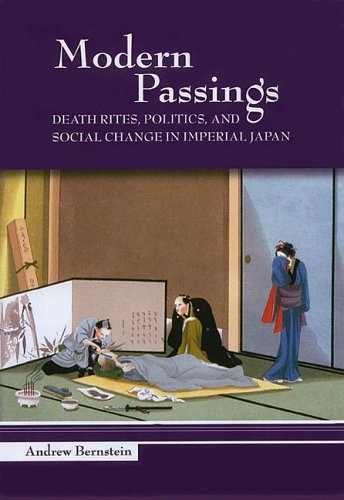Modern Passings: Death Rites, Politics, and Social Change in Imperial Japan
On Sale!- About the Book
-
What to do with the dead?
In Imperial Japan, as elsewhere in the modernizing world, answering this perennial question meant relying on age-old solutions. Funerals, burials, and other mortuary rites had developed over the centuries with the aim of building continuity in the face of loss. As Japanese coped with the economic, political, and social changes that radically remade their lives in the decades after the Meiji Restoration (1868), they clung to local customs and Buddhist rituals such as sutra readings and incense offerings that for generations had given meaning to death. Yet death, as this highly original study shows, was not impervious to nationalism, capitalism, and the other isms that constituted and still constitute modernity. As Japan changed, so did its handling of the inevitable.
Following an overview of the early development of funerary rituals in Japan,Andrew Bernstein demonstrates how diverse premodern practices from different regions and social strata were homogenized with those generated by middle-class city dwellers to create the form of funerary practice dominant today. He describes the controversy over cremation, explaining how and why it became the accepted manner of disposing of the dead. He also explores the conflict-filled process of remaking burial practices, which gave rise, in part, to the suburban “soul parks” now prevalent throughout Japan; the (largely failed) attempt by nativists to replace Buddhist death rites with Shinto ones; and the rise and fall of the funeral procession. In the process, Bernstein shows how today’s “traditional” funeral is in fact an early twentieth-century invention and traces the social and political factors that led to this development. These include a government wanting to separate itself from religion even while propagating State Shinto, the appearance of a new middle class, and new forms of transportation.
As these and other developments created new contexts for old rituals, Japanese faced the problem of how to fit them all together. What to do with the dead? is thus a question tied to a still broader one that haunts all societies experiencing rapid change: What to do with the past? Modern Passings is an impressive and far-reaching exploration of Japan’s efforts to solve this puzzle, one that is at the heart of the modern experience.
- About the Author(s)
-
Andrew Bernstein, Author
- Reviews and Endorsements
-
- Bernstein explores the invention of a ‘traditional’ Japanese way of death in modern times in this fascinating and challenging work. He elucidates the complex dynamics of the process with careful, balanced attention to the interactions among the state, organized religions, the funeral industry, and individual families. The writing is crisp, in places lyrical. The book is a pleasure to read and offers much to ponder.
—Andrew Gordon - Death is universal and apparently timeless, yet it has a history all its own. In Modern Passings, Andrew Bernstein recounts the story of a modernity that clothes itself in the shroud of tradition. From the debate over cremation to the invention of Shinto funerals, the history of death in Japan has been characterized by an ongoing struggle to invent traditions that seem at once ancient and modern; accommodate changing religious and social sensibilities; and secure Japan’s membership in the ranks of the world’s "civilized and enlightened" nations. Bernstein presents an incisive and fascinating look at a process that—like it or not—touches us all.
—David L. Howell - Death and funeral practices constitute fascinating topics, yet to my knowledge, Andrew Bernstein’s study is the first to take a broad overview of these topics for Japan. His work is both comprehensive and highly original, based on wide reading in the secondary and primary sources. The writing is excellent—witty and free of jargon. Highly recommended.
—Anne Walthall
- Bernstein explores the invention of a ‘traditional’ Japanese way of death in modern times in this fascinating and challenging work. He elucidates the complex dynamics of the process with careful, balanced attention to the interactions among the state, organized religions, the funeral industry, and individual families. The writing is crisp, in places lyrical. The book is a pleasure to read and offers much to ponder.
- Supporting Resources
-










